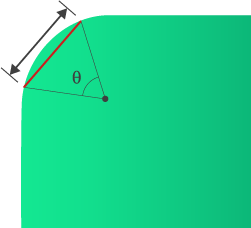The best way to optimize a mesh is to focus on the critical features and specify accurate meshing parameters accordingly, BEFORE generating the mesh. If the result is not as good as expected, we recommend remeshing the model with better parameters rather than trying to repair the defective mesh.
Here are the main quality parameters to consider for:
- SURFACE MESHES OPTIMIZATION
- Surface Edge Length
- The surface Edge Length gradient should be as constant as possible, meaning that the transitions between the fine and coarse triangles are smooth.
- Chord Angle
- To accurately mesh curved features, it may be helpful to locally modify the chord angle.

- Local mesh density
- Define Mesh Density tool allows you to locally change the chord angle and the surface edge length BEFORE meshing.
- Remesh area
- Remesh Area tool allows you to improve the gradient of the surface edge length AFTER meshing.
- Match ratio
- There is no limit on the match percentage, simply try the best. Use the Imprint tool to improve this match ratio.
- Diagnostics and manual editing
- Editing and repairing are different. For example, if you did not do it on the CAD model, you can manually edit the mesh to try to smooth a 90-degree angle.
- Design changes by mesh modification
- You can also try different shapes by manually modify the mesh to see impact on calculation.
- 3D MESHES OPTIMIZATION
- In general, do not repair 3D mesh. If any defect, first remesh with better surface mesh and once the surface mesh is correct, remesh with 3D mesh.
The important parameters to look at for a 3D mesh are:
- Maximum Dihedral angle
- The Dihedral angle is the angle between the faces. Click
 () to check it. It should be less or equals to 178, but the lowest the better.
Note: Do not worry about aspect ratio because Moldflow 3D mesher generates anisotropic 3D meshes with layers, while aspect ratio is an isotropic measure.
() to check it. It should be less or equals to 178, but the lowest the better.
Note: Do not worry about aspect ratio because Moldflow 3D mesher generates anisotropic 3D meshes with layers, while aspect ratio is an isotropic measure.
- Gate refinement
- It is important that the edge length is smaller at the entry point. Parameter it first on your surface mesh, before remeshing with 3D elements.